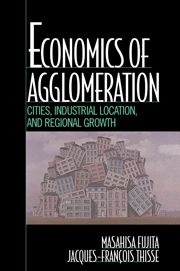Book contents
- Frontmatter
- Contents
- Acknowledgments
- 1 Agglomeration and Economic Theory
- PART I FUNDAMENTALS OF GEOGRAPHICAL ECONOMICS
- 2 The Breakdown of the Price Mechanism in a Spatial Economy
- 3 The Thünen Model and Land Rent Formation
- 4 Increasing Returns and Transport Costs
- 5 Cities and the Public Sector
- PART II THE STRUCTURE OF METROPOLITAN AREAS
- PART III FACTOR MOBILITY AND INDUSTRIAL LOCATION
- PART IV URBAN SYSTEMS AND REGIONAL GROWTH
- References
- Name Index
- Subject Index
4 - Increasing Returns and Transport Costs
The Fundamental Trade-Off of a Spatial Economy
Published online by Cambridge University Press: 05 June 2012
- Frontmatter
- Contents
- Acknowledgments
- 1 Agglomeration and Economic Theory
- PART I FUNDAMENTALS OF GEOGRAPHICAL ECONOMICS
- 2 The Breakdown of the Price Mechanism in a Spatial Economy
- 3 The Thünen Model and Land Rent Formation
- 4 Increasing Returns and Transport Costs
- 5 Cities and the Public Sector
- PART II THE STRUCTURE OF METROPOLITAN AREAS
- PART III FACTOR MOBILITY AND INDUSTRIAL LOCATION
- PART IV URBAN SYSTEMS AND REGIONAL GROWTH
- References
- Name Index
- Subject Index
Summary
INTRODUCTION
As seen in Chapter 2, a homogeneous space together with the competitive mechanism is not compatible with the existence of economic agglomerations such as cities. This is why we broached the assumption of homogeneity in Chapter 3 by assuming the existence of a prespecified center to which workers must commute. We did not, however, provide any justification for the existence of such a center.
One of the main reasons for a city center is the presence of scale economies in the aggregate, but such social returns remain to be explained. The standard approach is to appeal to Marshallian externalities. As argued in Chapter 1, this often amounts to using a black box. More interesting is a recent and growing literature that explores the specific factors that can generate such social scale economies. In this chapter, it is not our intention to provide a full survey of this new literature. Instead, we want to stress the importance of two forces, namely, the diversity of intermediate goods and the effect of the matching process on the labor market. Each factor lies at the origin of the division of labor and provides a foundation for increasing returns in the aggregate. Specifically, we will illustrate the advantages of specialization by showing how increasing returns may arise in the final goods sector when the intermediate goods sector is described by a monopolistic competition model. In addition, we will show how imperfect competition in thick labor markets, such as those encountered in big cities, allows for a reduction in average matching costs.
- Type
- Chapter
- Information
- Economics of AgglomerationCities, Industrial Location, and Regional Growth, pp. 93 - 132Publisher: Cambridge University PressPrint publication year: 2002



